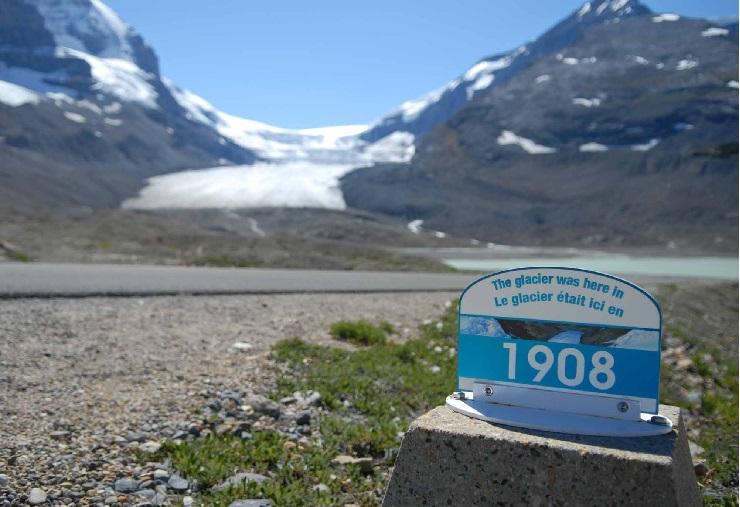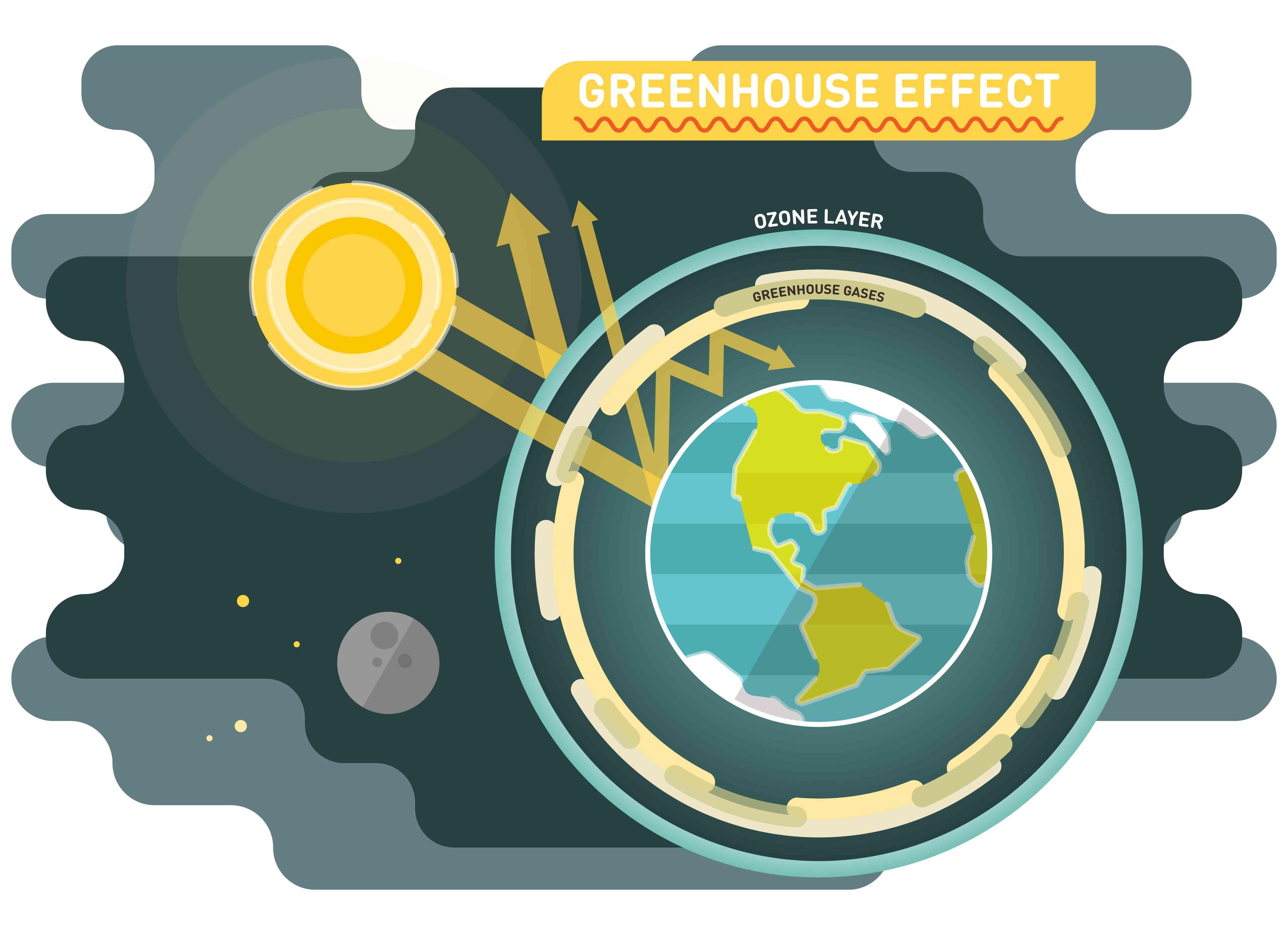Greenhouse effect
The greenhouse effect is a process in which gases such as methane, carbon dioxide and water vapour present in the Earth's atmosphere trap the sun's heat and thus keep the Earth and its lower atmosphere warm.
The name 'greenhouse' is derived from greenhouses or glasshouses used in higher altitudes and in temperate lands. The glass covering of a greenhouse allows solar radiation to penetrate through it but does not allow heat radiation to escape out.the heat trapped inside facilitates plant growth.
 Global Warming
Global Warming
Global warming is the long-term increase in Earth’s average surface temperature due to human activities, especially the emission of greenhouse gases like carbon dioxide (CO₂), methane (CH₄), and nitrous oxide (N₂O). These gases trap heat in the atmosphere, leading to a gradual rise in temperatures globally.
Causes
1. Burning of Fossil Fuels
The combustion of fossil fuels such as coal, oil, and natural gas for energy and transportation releases large amounts of carbon dioxide (CO₂) and other greenhouse gases into the atmosphere. This is the largest single source of global warming.
2. Deforestation
Trees absorb CO₂, so cutting them down reduces the planet’s capacity to absorb this gas, increasing its concentration in the atmosphere. Deforestation also contributes to the release of stored carbon in trees.
3. Industrial Processes
4. Agricultural Practices
5. Waste Management
Landfills produce methane as organic waste decomposes anaerobically (without oxygen). Improper waste management practices can significantly contribute to greenhouse gas emissions.
6. Transportation
Vehicles powered by gasoline and diesel emit CO₂ and other pollutants. The transportation sector is a major contributor to global warming.
7. Energy Production
Effect
1. Rising Temperatures
Global temperatures have been steadily increasing, leading to more frequent and severe heatwaves. This can cause health problems, reduce agricultural productivity, and increase energy demand for cooling.
2. Melting Ice Caps and Glaciers
The Arctic and Antarctic regions are warming faster than the rest of the planet, causing ice caps and glaciers to melt. This contributes to rising sea levels, which can lead to coastal flooding and erosion.

3. Sea Level Rise
As glaciers and ice caps melt, the added water increases sea levels. This threatens coastal communities, ecosystems, and infrastructure, potentially displacing millions of people.
4. Extreme Weather Events
Global warming is linked to more intense and frequent extreme weather events, such as hurricanes, droughts, and heavy rainfall. These events can cause significant damage to property, ecosystems, and human lives.
5. Ocean Acidification
Increased CO₂ levels lead to higher acidity in oceans, affecting marine life and ecosystems. This can harm coral reefs, shellfish, and other marine organisms that rely on calcium carbonate for their shells and skeletons.
6. Impact on Wildlife
Many species are struggling to adapt to the changing climate, leading to shifts in habitats and migration patterns. Some species face increased risk of extinction due to the rapid changes in their environments.
7. Agricultural Disruption
Changes in temperature and precipitation patterns can affect crop yields and food production. Some regions may experience reduced agricultural productivity, leading to food shortages and higher prices.
8. Health Risks
9. Water Scarcity
Changes in precipitation patterns and the melting of glaciers can lead to water shortages in some regions. This can affect drinking water supplies, agriculture, and industry.
Prevention
Reducing Greenhouse Gas Emissions
- Transition to Renewable Energy: Using solar, wind, hydroelectric, and geothermal energy reduces reliance on fossil fuels.
- Energy Efficiency: Improving energy efficiency in homes, buildings, and industries can significantly cut emissions.
- Electric Vehicles: Promoting the use of electric and hybrid vehicles reduces emissions from the transportation sector.
Reforestation and Afforestation
- Planting Trees: Trees absorb CO₂, so planting more trees and restoring forests can help sequester carbon.
- Protecting Forests: Preventing deforestation and promoting sustainable land use practices are crucial.
Sustainable Agriculture
- Improved Farming Practices: Techniques like crop rotation, reduced tillage, and organic farming can reduce emissions from agriculture.
- Methane Management: Managing livestock and rice paddies to reduce methane emissions is important.
Waste Management
- Recycling and Composting: Reducing waste sent to landfills and promoting recycling and composting can lower methane emissions.
- Waste-to-Energy: Converting waste into energy through processes like anaerobic digestion can reduce landfill use.
Policy and Regulation
- Carbon Pricing: Implementing carbon taxes or cap-and-trade systems can incentivize businesses to reduce emissions.
- International Agreements: Participating in global agreements like the Paris Agreement helps coordinate efforts to combat global warming.
Public Awareness and Education
- Raising Awareness: Educating the public about the causes and effects of global warming can encourage more sustainable behaviors.
- Community Initiatives: Supporting local initiatives and community projects aimed at reducing carbon footprints can make a significant impact.
Ozone layer
Ozone (trioxygen) is an inorganic molecule with the chemical formula O3. It is a pale blue gas with a distinctively pungent smell. The ozone layer or ozone shield is a region of Earth's stratosphere that absorbs most of the Sun's ultraviolet radiation. It contains a high concentration of ozone (O3) in relation to other parts of the atmosphere, although still small in relation to other gases in the stratosphere.Chlorofluorocarbons or CFCs are the main cause of ozone layer depletion. These are released by solvents, spray aerosols, refrigerators, air-conditioners, etc.
The molecules of chlorofluorocarbons in the stratosphere are broken down by ultraviolet radiations and release chlorine atoms. These atoms react with ozone and destroy it.
Montreal Protocol
The Montreal Protocol on Substances That Deplete the Ozone Layer is an international treaty designed to protect the ozone layer by phasing out the production of numerous substances that are responsible for ozone depletion. It was agreed on 16 September 1987, and entered into force on 1 January 1989.
Ozone's whisper
In the upper realms, where sky meets space, A fragile shield once held its place. Ozone, our guardian, stood strong and true, Shielding Earth from the sun’s fierce hue.
But alas, we humans, with our industry’s might, Unleashed chlorine and bromine into the light. Chemical compounds, insidious and sly, Began their dance, reaching for the sky.
Over Antarctica, the thinning began, A silent battle fought by this noble clan. The polar regions bore the brunt of strife, As ozone waned, yielding to a harsher life.
Yet hope emerged—a global accord, The Montreal Protocol, our shield restored. Nations united, pledged to cease the harm, Halting the chemicals that caused alarm.
So let us remember, as we tread this sphere, Ozone’s whisper still echoes, crystal clear. A call to protect, to mend what’s torn, For Earth’s fragile shield, forever reborn.
Remember, my friend, our duty lies, To heal the wounds, under azure skies. 🌍✨
*******

